
How To Treat And Prevent Pests On San Pedro Cactus
Growing San Pedro is fairly straightforward, and most often this hardy cactus is quite capable of looking after itself. But sometimes, various creatures may decide that it seems like a hospitable home! Here we show you how to identify and treat potential pests that may afflict your San Pedro cactus.
San Pedro (Echinopsis pachanoi) is a cactus native to South America, thriving in the low, dry region of the Andes mountains. Famous and well-loved for its high mescaline content, it’s a psychoactive plant capable of inducing a powerful psychedelic trip, and has been used for generations by a variety of South American cultures. Though distinct from the more famous peyote (Lophophora williamsii) of Central America, common pests affect both cacti, so you can use this guide for peyote too.
Despite being resilient, San Pedro is, like all plants, susceptible to pests that can cause varying degrees of damage, depending on the type of pest and severity of the infestation. If you’re growing San Pedro at home, whether on the windowsill or in the garden, it helps to know a little about how to care for it, and what to do if pests appear. This article will provide detailed information on identifying, treating, and preventing pests on your San Pedro cactus to keep it healthy and thriving.
Which bugs eat San Pedro cacti?
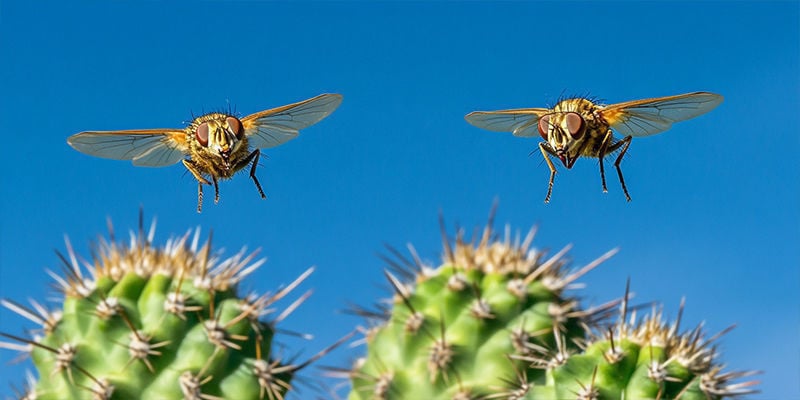
In general, there are several pests that can infest San Pedro cactus, at least in the temperate areas of Europe in the US. Each of these insects causes a slightly different type of damage, which can help when it comes to identifying the culprit, and figuring out the solution! Below, find a list of common pests and a few signs of how to spot them.
- Fungus gnats and fruit flies: These live in the soil and feed on the cactus itself. Though they probably won’t bring an end to your cactus, they can slow its growth and can be extremely annoying. Plus, they breed like, well, flies. You’ll notice them because every time you go near your cactus, a swarm of flies will erupt from it.
- Scale insects: These can be difficult to spot, as they are fairly flat and lie like innocuous little lumps on the surface of the cactus, appearing like a part of the cactus itself. But in fact, they are sucking out the cactus’ sap, which drains its energy, weakens its immune system, and slows growth.
- Mealybugs: These insects will hide in cracks and crevices, and are easy to spot as they leave a cotton web-like substance in their residences. If left unchecked, they will spread quickly and can damage your plant. The presence of ants on your cactus may also indicate mealybugs, as the former are known to farm the latter for their sweet honeydew excrement.
- Thrips: These live mostly on fresh, softer new growth. Though hard to spot themselves, you can tell they’ve been around because they’ll leave silver trails and black specks in their wake.
- Red spider mites: If you notice brown spots and webbing on your San Pedro or peyote cactus, it might be that you have a red spider mite infestation. These little creatures will also feast on the sap of your cactus, draining its energy.
How to get rid of pests on San Pedro cacti
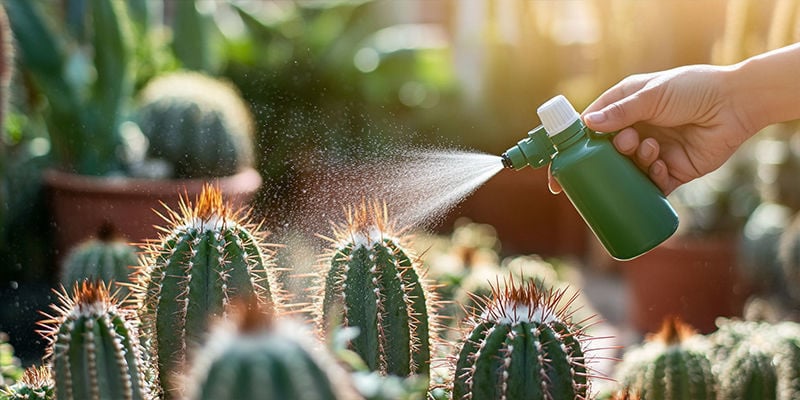
To effectively treat pest infestations on your San Pedro cactus, it’s crucial to understand each type of pest and the appropriate treatment methods. Fortunately, treatments are mostly similar and all pretty straightforward, so there’s no need to fret! Here’s an overview of what to do with each common pest.
Fungus gnats and fruit flies
These insects can be a pain to get rid of, but there are a couple of ways to deal with them. First, they hate dry environments (unlike cacti), and this can be put to good use. As they nest in the soil, allow it to dry out entirely and leave it this way for some time. Fungus gnats and fruit flies won’t be able to cope with the period of drought, but the cactus will survive just fine.
You can also use sticky traps to help catch the adults who are flying around and causing a nuisance. This will make them less annoying and reduce the rate at which they are able to breed. This method alone, however, is not sufficient to bring an end to an infestation.
These pests are also susceptible to organic pesticides such as neem oil, so a liberal application of this can help to kill them off.
Scale insects
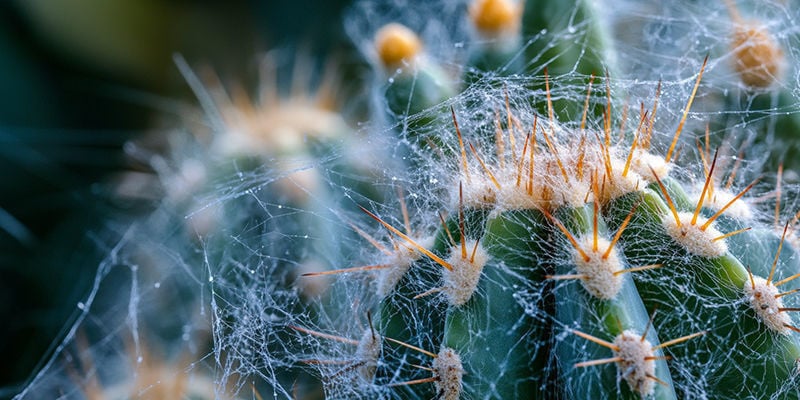
Scale insects can be slightly annoying to remove as they cling on tight. That being said, it’s still fairly straightforward—it might just require a little elbow grease!
One option is to use a cotton swab dipped in rubbing alcohol and remove them one at a time. This ensures you get them all, but can be quite labour intensive if the infestation is significant. So, alternatively, you can use an insecticidal soap or neem oil solution and spray the affected areas. Repeat this treatment as much as necessary for the infestation to subside.
Mealybugs
Mealybugs breed and spread quickly, but can also be dealt with equally quickly. To remove them, simply spray with neem oil until the infestation is eradicated. As a preventative measure, it can help to regularly clean (wipe with a wet cloth) your cactus, as this can be enough to remove the odd mealybug and keep infestations at bay.
Thrips
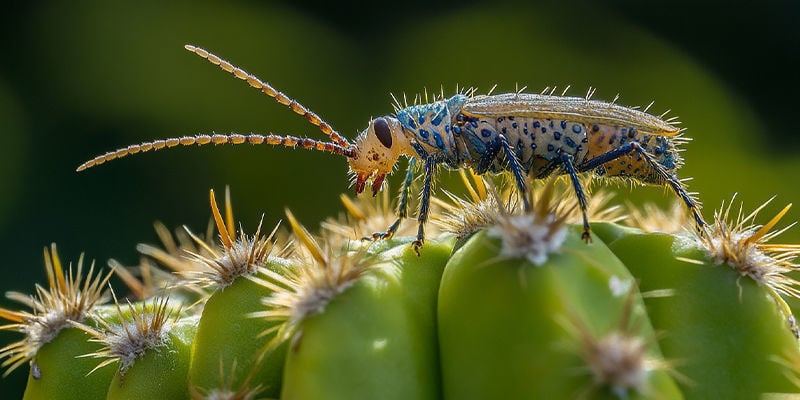
These insects may not die off when exposed to insecticidal soap or neem oil, although many say that these solutions do work effectively. Others suggest more intense pesticides, but we’d always suggest going for the organic option first, and then going from there.
You can also use other insects, such as lacewings and ladybugs, to help defeat your thrip problem. These insects are voracious predators and will hunt down and eat thrips. Though it might not work to tackle a full-blown infestation, they work well as a preventative strategy.
Spider mites
Spider mites can sometimes be removed simply with a jet of strong water. If this doesn’t work, you can use—you guessed it—neem oil! Alternatively, you can employ miticides or insecticidal soap to do your dirty work.
Keeping plants clean is a great way to prevent spider mites, and other pests, so you should regularly give your plants a spray with the hose, at the very least, to help prevent these critters from building up a colony.
Tips for preventing pests on San Pedro cacti
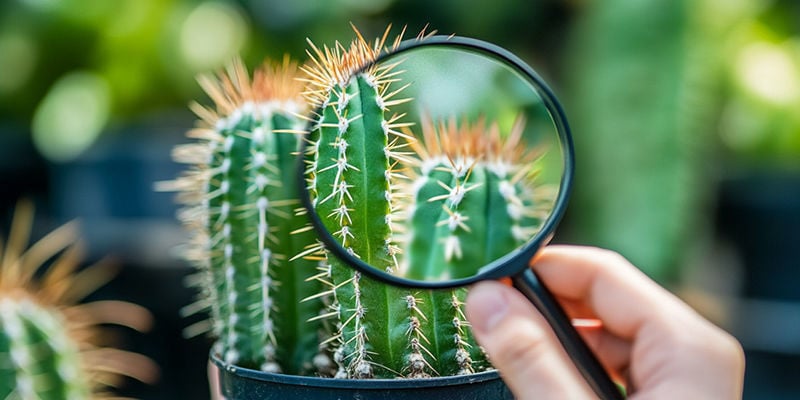
Prevention is the best defence against pest infestations, and almost all other problems in the world—you heard it here first! Here are some tips to keep your San Pedro cacti pest-free.
- Proper watering: Overwatering can attract pests, and overly moist soil is the perfect breeding ground. Ensure the soil dries out between waterings. What’s more, it’s no secret that cacti love dry soil, so San Pedro and peyote are particularly well-suited to this method of prevention.
- Regular inspection: Regularly check your cactus for signs of pests and deal with them early on. If you notice something crawling around, sometimes simply wiping it off with a wet cloth will be enough to avoid a problem.
- Clean environment: Keep the area around your cactus clean and free of debris, as the more places there are for pests to lurk, the more likely they are to make an appearance.
- Isolate new plants: Quarantine new plants before introducing them to your collection to ensure that any infestation they are harbouring rears its head in isolation.
- Companion plants and predatory insects: Planting companion plants alongside your cacti can help to deter would-be cactus predators and attract beneficial insects, such as those mentioned above. Using nature in this way can help to create natural defences and improve your little ecosystem.
Can I spray rubbing alcohol on a cactus?
Yes, you can spray rubbing alcohol on your cactus. It is an effective treatment for many pests, such as mealybugs and scale insects, and it tends to kill immediately on contact, making it a faster solution compared to other treatments. However, it’s essential to use it sparingly, and directly on the pests, to avoid damaging the plant.
Keep your San Pedro cactus healthy
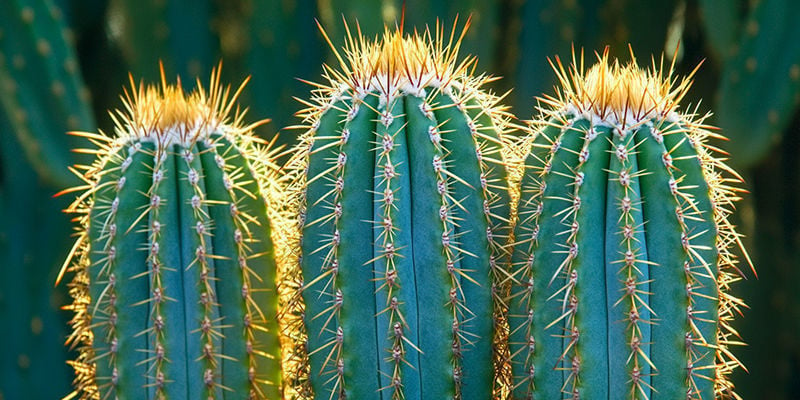
Maintaining the health of your San Pedro cactus involves regular care and vigilance against pests, but is typically a fairly easy affair due to its resilience and dry growing conditions. By following the treatments and preventive measures outlined in this guide, you can spot and solve any issues quickly as they occur, making your life much easier.
Tend to your psychoactive cacti well, and at some point in the future they will reward you with an experience unlike any other!
-
 4 min
17 June 2025
Top 5 cactus care mistakes and how to correct them
Cacti are hardy and low-maintenance, but they still have specific needs. Overwatering, poor soil, and lack of light are just a few common cactus care mistakes that can cause problems. Learn how to...
4 min
17 June 2025
Top 5 cactus care mistakes and how to correct them
Cacti are hardy and low-maintenance, but they still have specific needs. Overwatering, poor soil, and lack of light are just a few common cactus care mistakes that can cause problems. Learn how to...
-
 6 min
12 March 2025
How to grow and care for the San Pedro cactus
Growing plants is a very satisfying endeavour—even more so when they make you trip! Here, we'll look at how to grow San Pedro—an iconic psychoactive cactus—from seeds and cuttings.
6 min
12 March 2025
How to grow and care for the San Pedro cactus
Growing plants is a very satisfying endeavour—even more so when they make you trip! Here, we'll look at how to grow San Pedro—an iconic psychoactive cactus—from seeds and cuttings.
-
 5 min
27 November 2019
How To Grow Your Own Mescaline Cactus From Seed
Mescaline is a natural psychedelic produced by several types of cactus including peyote, San Pedro, and the Peruvian torch. These cacti are easy enough to grow, even if you don't have a lot of...
5 min
27 November 2019
How To Grow Your Own Mescaline Cactus From Seed
Mescaline is a natural psychedelic produced by several types of cactus including peyote, San Pedro, and the Peruvian torch. These cacti are easy enough to grow, even if you don't have a lot of...
-
 3 min
2 June 2017
Mescaline Cacti Differences
Mescaline is a psychoactive compound found in several species of cacti. Each species provides its own interpretation of the mescaline experience. How do the effects differ from species to species?...
3 min
2 June 2017
Mescaline Cacti Differences
Mescaline is a psychoactive compound found in several species of cacti. Each species provides its own interpretation of the mescaline experience. How do the effects differ from species to species?...





 United States
United States











